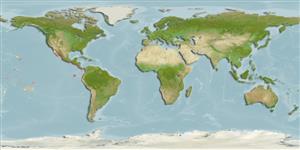Common names from other countries
>
Blenniiformes (Blennies) >
Blenniidae (Combtooth blennies) > Salariinae
Etymology: Hypsoblennius: Greek, hypsi = high + Greek, blennios = mucus (Ref. 45335).
More on author: Günther.
Environment: milieu / climate zone / depth range / distribution range
Ecología
marino asociado a arrecife; rango de profundidad 1 - 10 m (Ref. 37955), usually 2 - 6 m (Ref. 5227). Tropical
Eastern Pacific: central Gulf of California to Peru, including the Galapagos and Cocos islands.
Tamaño / Peso / Age
Maturity: Lm ? range ? - ? cm
Max length : 12.0 cm TL macho / no sexado; (Ref. 2272)
Adults are found in rocky areas (Ref. 37955). They inhabit empty barnacle shells, often with only the head protruding. They feed by nabbing bits of floating food (Ref. 5227). Oviparous (Ref. 205). Eggs are demersal and adhesive (Ref. 205), and are attached to the walls of the parent's shelter (Ref. 56053). Eggs are brooded by the male parent (Ref. 56053). Minimum depth reported from Ref. 5227.
Life cycle and mating behavior
Maturities | Reproducción | Spawnings | Egg(s) | Fecundities | Larva
Oviparous, distinct pairing (Ref. 205).
Thomson, D.A., 1987. Reef fishes of the Sea of Cortez. The rocky-shore fishes of the Gulf of California. The University of Arizona Press, Tucson. 302 p. (Ref. 5592)
IUCN Red List Status (Ref. 130435)
CITES (Ref. 128078)
Not Evaluated
Threat to humans
Harmless
Human uses
Pesquerías: comercial; Acuario: Comercial
Herramientas
Special reports
Download XML
Fuentes de Internet
Estimates based on models
Preferred temperature (Ref.
115969): 22.4 - 29.1, mean 26.7 (based on 223 cells).
Phylogenetic diversity index (Ref.
82804): PD
50 = 0.5000 [Uniqueness, from 0.5 = low to 2.0 = high].
Bayesian length-weight: a=0.00741 (0.00335 - 0.01640), b=3.02 (2.83 - 3.21), in cm Total Length, based on LWR estimates for this (Sub)family-body shape (Ref.
93245).
Nivel trófico (Ref.
69278): 2.0 ±0.00 se; based on food items.
Resiliencia (Ref.
120179): Alto, población duplicada en un tiempo mínimo inferior a 15 meses (Preliminary K or Fecundity.).
Fishing Vulnerability (Ref.
59153): Low vulnerability (10 of 100).
